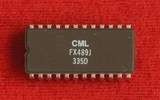FX489
Features
- Full-Duplex Gaussian Minimum Shift Keying
- Selectable BT (0.3 or 0.5)
- Meets RAM - MOBITEX Specification
- Data Rates From 4000 bits/s to 19200 bits/s
- Serial Rx and Tx Data Interfaces
Applications
- Rx and Tx Data Clock Generation
- Rx Signal Tracking Controls
- Rx S/N Indication
- Separate Rx and Tx Powersave Inputs
- Wireless Modem, Radio Telemetry and Data Terminal Applications
Brief Description
The FX489 is a single-chip modem employing Gaussian Minimum Shift Keying (GMSK) modulation. Having a pin-selectable BT of 0.3 or 0.5, the FX489 may be operated at data rates between 4000 bits/s and 19200 bits/s. For use in FM radio data links and data communication systems conforming to DOC and FCC spectrum limitations for 12.5kHz and 8,000 baud at a BT of 0.3, and 12.5, 25.0, and 50kHz channel spacing and data rates of 4800, 9600 and 19200 baud respectively at a BT of 0.5.
The Rx and Tx digital data interfaces are bit-serial and synchronised to Rx and Tx data clocks generated by the modem. Separate Rx and Tx Powersave/Enable inputs allow for full- or half-duplex operation.
Rx input levels can be set by a suitable a.c. and d.c. level adjusting circuit built, with external components, around an on-chip Rx input amplifier.
Acquisition, lock and hold of Rx data signals are made easier and faster by the use of Rx Control Inputs to clamp, detect and/or hold input data levels and can be set by the µProcessor as required.
The indication of the quality of the received signal is available from the Rx S/N output.
The FX489, a low-power CMOS microcircuit, is available in both 24-pin plastic Small Outline (S.O.I.C) and DIL packages.
Clock Oscillator and Dividers
The Tx and (nominal) Rx data rates are determined by the division of the frequency present at the Xtal pin, which may be generated by the on-chip Xtal oscillator or be derived from an external source.
The division ratio is controlled by the logic level inputs on the ClkDivA/B pins and is shown in the table below - together with an indication of how various ‘standard’ data rates may be derived from common µP Xtal frequencies.
Radio Channel Requirements
To achieve legal adjacent channel performance at high bit-rates, a radio with an accurate carrier frequency and modulation index will be required.
To achieve optimum channel utilisation, (e.g. Low BER and high data-rates) attention must be paid to the phase and frequency response of both the IF and
baseband circuitry.
